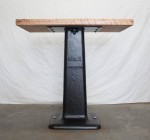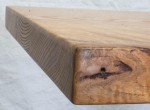Even though ‘repurposing’ has become an overused and somewhat annoying buzzword, I think the underlying concept is sound on many levels, and even noble in an environmental context.
This table is the happy marriage involving a cast off cast iron pedestal for some forgotten stationary machine. I tried researching ‘Excelsior’ and variations, and came up with very little information. I was surprised, because the internet usually knows everything.
Sadly, this base had stood in a puddle of water for years, so the original finish was damaged. Happily, the cast iron was untouched, so it was just a matter of refinishing it. Bear in mind that in the era in which this base was cast, pride of manufacturing required that imperfections, such as casting seams and non-structural pits and pinholes, be improved before delivery to the customer. A common method of repair was to fair these blemishes in with a layer with lead in one form or another. Re-working the finish on antique cast iron runs the risk of creating airborne lead particles. Appropriate caution and technique is a necessity.
The new finish is an alkyd enamel that I mixed up especially for this project. It’s nearly black, showing a dark coffee brown in very strong light. It’s not quite a full gloss. I enjoy working with paints, and after five years in a body shop, I can usually mix pretty much whatever I want.
The other half of the marriage is a slab of wood that had been hanging around my shop for so long that I’ve forgotten where it came from. Apparently, it was just waiting for this base to come along. It may be oak, possibly chestnut, and measures 34″x 17-1/2″ x 1-3/4″ thick. A few wormholes, nail holes and checks add character to a spectacular radial grain pattern. The edges are marked with exquisite ribboning.
Attaching the top and base required fabricating an adapter plate with studs welded to it to fasten it to the base. Oversized holes for the wood screws allow the wood to move with seasonal expansion and contraction.
As an afterthought, I covered the mounting bolt holes in the bottom of the base with a pair of chrome bumper bolts. Bumper bolts have disappeared with the advent of plastic covered energy-absorbing bumpers, but they used to be common. Writing up this post triggered a memory regarding bumper bolts; I’m sure everyone has at least one:
Many years ago, I traveled about with my camera taking photos in the hope of selling a print or two. At one point, I wandered into gravel yard. I snapped shots of drivers in their dump trucks, and eventually found my way into the office. There, a group of drivers began swapping tales, at least partly for the benefit of the pony-tailed kid with the camera.
An older, sunburned driver with a Camel unfiltered voice told about the time he crested a rise in a loaded Mack, only to see a Cadillac stopped dead ahead, which he smacked square in the back. An older lady got out, rattled but apparently unharmed, looked at the back of her car didn’t see any damage. Words were exchanged and they parted without any police or insurance involvement. The driver gleefully wrapped up his tale, noting that from the height of his truck’s cab he had seen the roof of the Cadillac buckle and crease over the rear doors, the result of the violent energy of the collision. There was no damage to the rear of the car, he said, because he had managed to contact only the bumpers bolts, sending the force of the impact down the car’s frame to dissipate elsewhere, neatly folding the entire car upward a little. I cleaned up his language a little bit, but the facts remain unchanged. I still have about ten pounds of chrome bumper bolts, in various sizes.







